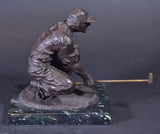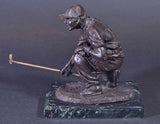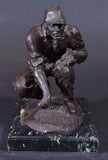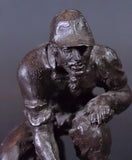Bronze Golf Sculpture, a Man In a Crouched Position Eyeing The Green.
Bronze Golf Sculpture, a Man In a Crouched Position, Eyeing The Green, Stone Base, Nice Patina, 1950.
The Art Of The Lost-Wax Process
The earliest known “lost wax” castings date from the early dynasties of Egypt, nearly 7,000 years ago, when metal was poured into “investments” of fired clay that had been shaped with the help of wax that was melted, or “lost”. Then, sometime between 4,000 and 3,000 B.C., bronze was discovered, probably by accident, as being a metal that was harder than copper or tin alone. Thus began the era known as the Bronze Age. Ancient “lost-wax” bronze castings have withstood the centuries, visually telling the tale of past cultures, their religions, and their social structures. For example, Chinese bronzes depicted ceremonial images; Indian and Egyptian castings symbolized deities; Africans cast images of nature, and the Greeks recreated the human form.
Many of these cultures have since grown obsolete, their religions have evolved and societies have changed. Elements of the “lost-wax” process have been refined. Yet today, bronze casting is essentially the same as it was in 2,000 B.C. during the Akkadian period. Bronze is an alloy of 95% copper, 4% silicon, and 1% manganese with traces of other elements such as iron. Silicon bronze has been the bronze of choice for fine art castings since its development in the 1920s. It is corrosion-resistant, strong, resilient, formable and weldable. Also known as "hot-cast" bronze, a fine art "lost-wax" casting of silicon bronze is created through many labour-intensive steps.
Item Code - BRO2C2390LJD
Width: 3 5/8" Height: 6" Depth: 7 3/8" Weight: 1.708 kg













